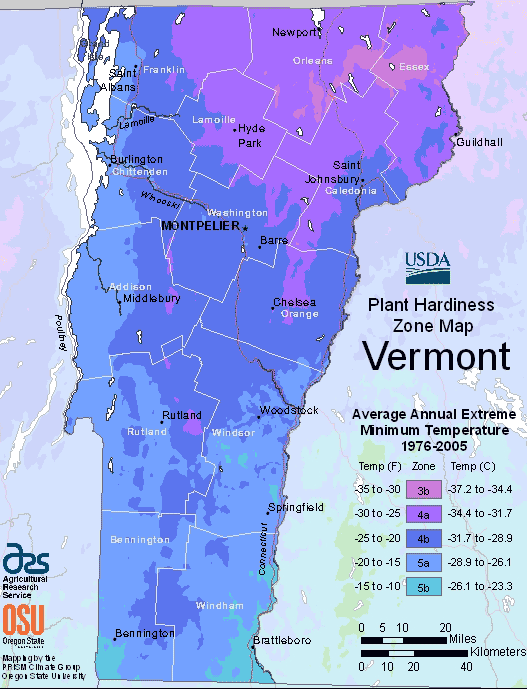
Table of Contents
Characteristics of Vermont Planting Region
In this region, the growing season is brief. On average, the frost-free period usually starts in mid-May and usually finishes in early October. However, these dates may vary significantly in different parts of the state, so be sure to check the frost dates for your area.
Challenges of Growing in Vermont
1. Short Growing Season
A short growing season restricts many plants from fully maturing before the first freeze. Combining indoor and outdoor cultivation may be necessary to maximize the amount of time for growth in certain regions.
2. Flooding
Flooding can pose significant challenges for gardening in Vermont’s planting zone, particularly in low-lying areas and regions with poor drainage. you may need to choose flood-tolerant plants and implement raised beds or improved drainage systems to mitigate the impact of excess water and protect their gardens from damage
3. Heavy Snowfall
The considerable amount of snow in the area could impede your ability to keep your plants alive in the winter. Growing indoors or in a sheltered environment may be necessary for their survival.
Flourishing in the Green Mountain State: Best Plants for Vermont’s Planting Zone
Selecting the right plants is essential to create a thriving garden in Vermont’s dynamic climate. Here are some of the best plants to grow in Vermont’s planting zone:
- Lilacs (Syringa spp.): Lilacs are a beloved favorite in Vermont gardens, known for their enchanting fragrance and clusters of colorful blooms in shades of purple, pink, white, and blue. These hardy deciduous shrubs add charm and nostalgia to the landscape.
- Hostas (Hosta spp.): Vermont’s shade-loving perennial, Hostas, are prized for their attractive foliage and low-maintenance nature. With a variety of sizes, shapes, and colors available, they make stunning additions to woodland gardens and shaded areas.
- Daylilies (Hemerocallis spp.): Daylilies are easy-to-grow perennials that offer a profusion of colorful blooms throughout the summer. With a vast selection of hues and patterns, they are a versatile and popular choice for Vermont gardens.
- Peonies (Paeonia spp.): Known for their large, showy flowers and delightful fragrance, Peonies are a must-have for Vermont gardens. These hardy perennials add elegance and beauty to any landscape.
- Vermont Sugar Maple (Acer saccharum): As the state tree of Vermont, the Sugar Maple is iconic for its brilliant fall foliage. These large deciduous trees provide shade and beauty to landscapes, as well as being the source of maple syrup production.
- Bee Balm (Monarda spp.): Bee Balm is a perennial herb that produces striking, nectar-rich flowers in shades of pink, red, and purple. Besides attracting bees and butterflies, it adds vibrant color to cottage and pollinator gardens.
- Hydrangeas (Hydrangea spp.): Hydrangeas are versatile shrubs that bloom abundantly in the summer. Their large flower heads come in various colors, depending on soil pH, and add a touch of elegance to Vermont gardens.
- Joe-Pye Weed (Eutrochium purpureum): This native perennial thrives in Vermont’s moist areas and attracts butterflies with its pinkish-purple flower clusters. It adds height and interest to wildflower gardens and rain gardens.
- Northern Red Oak (Quercus rubra): Northern Red Oak is a native deciduous tree that provides shade and striking fall foliage to Vermont landscapes. Its sturdy nature makes it an excellent choice for urban and suburban environments.
- Coneflowers (Echinacea spp.): Coneflowers are tough and adaptable perennials that thrive in Vermont’s planting zone. Their showy daisy-like flowers in shades of pink, white, and purple attract butterflies and pollinators.
To ensure successful gardening in Vermont, it’s crucial to consider the state’s changing seasons and diverse microclimates. Some parts of Vermont have colder temperatures and more prolonged winters, while others enjoy milder weather and longer growing seasons.
Soil preparation and mulching play a vital role in retaining moisture and protecting plants during cold winters. Gardeners may also use season extension techniques, like cold frames and row covers, to start planting early in the spring and extend the growing season in the fall.
Watering practices should be adjusted according to the specific needs of each plant and the prevailing weather conditions. Proper irrigation and drainage help maintain soil moisture and prevent waterlogging.
Incorporating native plants into Vermont gardens supports the local ecosystem and provides essential habitat for wildlife. Native plants are naturally adapted to the region’s conditions and require less maintenance, making them a sustainable choice for environmentally conscious gardeners.
From the timeless beauty of lilacs and peonies to the hardiness of native trees like Sugar Maples and Red Oaks, the best plants for Vermont gardens celebrate the state’s natural beauty and complement its distinctive New England charm. By embracing the region’s changing seasons and employing proper care, gardening enthusiasts can enjoy flourishing gardens that thrive in Vermont’s dynamic climate and provide a haven for local wildlife.
FAQ
What growing zone is Montpelier Vermont?
Montpelier, VT is in Zone 4b (USDA Hardiness).
What planting zone is Stowe Vermont?
Stowe, VT is in Hardiness Zone 4b (USDA).
What planting zone is the northeast?
The Northeast is in USDA Plant Hardiness Zones 3-7 and AHS Heat Zones 1-6.
What zone is Vermont for growing?
In Vermont, temperatures in winter range from cold (Zone 3b) to warmer (Zone 5b). These five zones are designated as 3b, 4a, 4b, 5a, and 5b.
What planting zone is NY?
Timing is essential for maximizing your veggie garden’s yield. Utilize your first and last frost dates to determine when to sow your seeds. New York falls in USDA hardiness zones 3-7.
